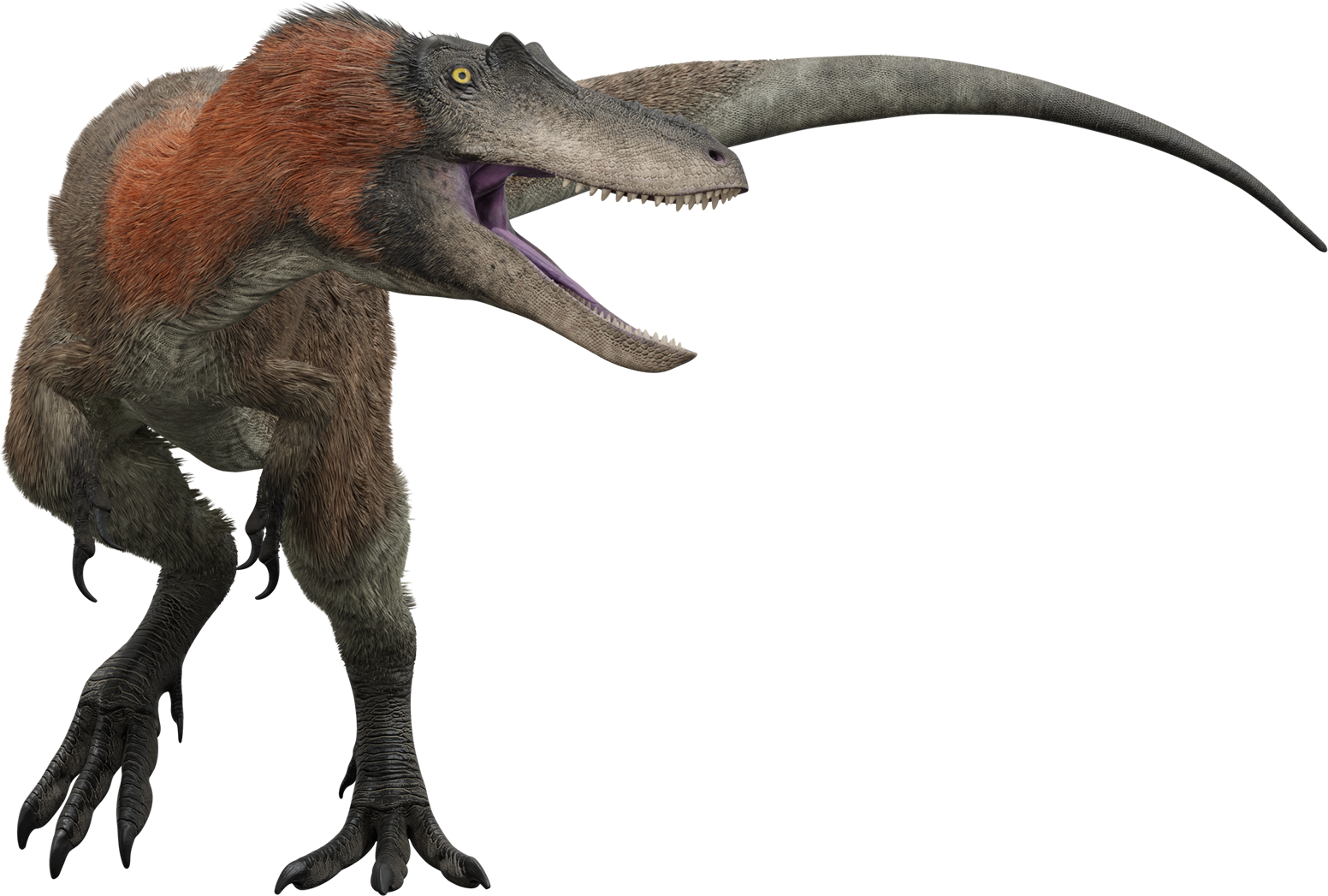Overview: When most people think of tyrannosaurs, they think of massive, powerful, and robust predators like T-rex. But one branch of the tyrannosaurid family tree took a different approach, retaining juvenile characteristics into adulthood and developing highly elongated snouts and becoming fleet-footed predators of small to medium-sized prey. The last and largest of these was Qianzhousaurus from Ghanzhou, China. The discovery of Qianzhousaurus proved that these gracile, long-snouted predators weren’t just juveniles of larger animals, or a one-off fluke closely related to other Asian tyrannosaurs, but a unique branch of tyrannosaurs endemic to eastern Asia.
Discovery: Qianzhousaurus sinensis is known from a single specimen discovered in the Late Cretaceous rocks of the Nanxiong Formation in Ghanzhou, China in 2010. It was discovered by construction workers during the construction of an industrial park, who brought the fossils to the local Ghanzhou Museum. The skeleton, which was of a subadult, consisted of a nearly complete skull, 9 cervical (neck) vertebrae, 3 dorsal (back) vertebrae, 18 caudal (tail) vertebrae, both scapulocoracoids (shoulder blades), partial ilia (part of the pelvis), and most of the left leg, compromised of the femur, tibia, fibula, astragalus, calcaneum, and metatarsals III and IV. In 2014, it was described and named by Lü Junchang and colleagues. Its name means “Ghanzhou lizard”, Quianzhou being the former name of Ghanzhou. Its species name means "from China”.
Evolution: Qianzhousaurus was a type of tyrannosauroid. Tyrannosauroids were a clade of coelurosaurian theropods (theropods closer related to birds than to other theropods like Allosaurus) which first appeared in the Middle Jurassic and came to prominence in the Cretaceous. Most analyses place Qianzhousaurus and its slightly earlier close relative Alioramus within the family Tyrannosauridae and within Tyrannosaurinae (closer to T-rex than to Albertosaurus). Tyrannosaurids evolved sometime between 90 and 81 million years ago in North America where they became apex predators. Eventually some tyrannosaurids migrated to Asia. Large Asian forms include Zuchengtyrannus (73.5 Ma) and Tarbosaurus (70 Ma). But Qianzhousaurus and Alioramus, together classified in the tribe Alioramini, represent a different branch of tyrannosaurs so far unique to Asia, possibly branching off early in the evolution of tyrannosaurines. However, another analysis suggests that the Alioramini may actually lie just outside of Tyrannosauridae, and thus while they are certainly tyrannosauroids, they may not be true tyrannnosauids. If not tyrannosaurids, then they likely evolved in Asia from Asian tyrannosauroid ancestors, which would explain why there are no American representatives of Alioramini. However, while their phylogenetic position is somewhat uncertain, they are currently treated as a unique branch of tyrannosaurine tyrannosaurids, and thus would have been descended from North American tyrannosaurines at some point in their evolution. Alioramus is the closest relative of Qianzhousaurus and lived a few million years earlier in Mongolia. It is possible that Alioramus could be an ancestor of Qianzhousaurus, and it has even been suggested in a 2017 study that Qianzhousaurus sinensis should actually be classified as a species of Alioramus, but a 2022 study provides evidence that the two are different enough to warrant separate genera.
Description: Qianzhousaurus was on the smaller side by tyrannosaur standards, being estimated at 6.3 m (20.7 ft) long, 2 m (6.6 ft) tall at the hips and weighing 750–757 kg (1,653–1,669 lb). However, as the only known specimen was a subadult, it is possible that it may have had a slightly longer adult length between 7.5 and 9 m (25 and 30 ft). In any case, it was also a more lightly built theropod than other tyrannosaurids, with a gracile build, long legs, and a relatively long snout with thin, blade-like teeth. These are all features associated with juvenile tyrannosaurids. In fact, it was once suggested that Alioramus might be a juvenile Tarbosaurus, but the discovery of a second species of Alioramus and actual juvenile Tarbosaurus disproved this. Qianzhousaurus further confirms that alioramins are a legitimate branch of tyrannosaurs, not just the juveniles of bigger tyrannosaurs. These unique animals appear to maintain juvenile characteristics throughout their life, setting them apart from their relatives. While a slightly proportionally longer snout and lighter built skull is indeed a juvenile trait in tyrannosaurs, alioramins like Qianzhousaurus have uniquely elongated snouts, further setting them apart from other tyrannosaurs. Like Alioramus, Qianzhousaurus had a ridge of low bumps running down its snout, and small but prominent hornlets over its eyes, perhaps a type of display ornamentation.
Ecology: Qianzhousaurus lived in a floodplain environment with a humid subtropical climate. Like other tyrannosaurs, Qianzhousaurus was a carnivore. However, unlike most other tyrannosaurs, Qianzhousaurus lacked the bone crunching power and robust build that characterizes the group. Instead Qianzhousaurus probably used its proportionally long legs and lightweight build to run down smaller swifter prey. This hunting style likely helped its relative Alioramus avoid competition with the much larger tyrannosaur Tarbosaurus. It is unknown if Qianzhousaurus coexisted with larger tyrannosaurs or if was an apex predator. No large tyrannosaur material has been reported from the Nanxiong Formation, but it is entirely possible that a large Tarbosaurus-like tyrannosaur, or perhaps even Tarbosaurus itself could have lived in the region. Nevertheless, Qianzhousaurus is the largest predator known from its formation. It seems to have lived alongside a great variety of oviraptorosaurs, including Corythoraptor, and these may have been its primary prey.
Extinction and Legacy: Qianzhousaurus lived at the tail end of the Age of Dinosaurs and went extinct in the same asteroid-induced global cataclysm which wiped out all of the dinosaurs, with the exception of a few lineages of birds. Today, Qianzhousaurus’s bones are held at the Ganzhou Museum, Ganzhou City, Jiangxi Province, China. Qianzhousaurus was featured in the fifth episode of the 2022 BBC documentary Prehistoric Planet, alondside its presumed prey, Corythoraptor.
Quianzhousarus FAQ
Quianzhousaurus size / How big was an Quianzhousaurus?
See height, weight, and length.
Quianzhousaurus height / How tall was Quianzhousaurus?
Quianzhousaurus was probably about 2 meters (6.6 ft) tall at the hips, or about 2.5 meters (8.2 ft) tall at the top of its head.
Quianzhousaurus weight / How much did an Quianzhousaurus weigh?
Quianzhousaurus probably weighed about 750–757 kg (1,653–1,669 lb), though the holotype is only a subadult so adults may have weighed a bit more.
How long was Quianzhousaurus?
Quianzhousaurus is thought to have grown somewhere around 7.5-9 m (25-30 ft) long as an adult.
What did Quianzhousaurus eat?
Quianzhousaurus ate meat, prossibly fleet-footed medium-sized dinosaurs like the oviraptorosaur Corythoraptor,.
What is Quianzhousaurus’s closest living relative?
Like all dinosaurs, the closest relatives of Quianzhousaurus are the only surviving lineage of dinosaurs today, the birds. Crocodilians, while not dinosaurs themselves, are also more distant cousins of dinosaurs.
Quianzhousaurus family members / Quianzhousaurus family / What kind of dinosaur was Quianzhousaurus?
Quianzhousaurus was a theropod (two-legged, mainly carnivorous dinosaurs) in the family Tyrannosauridae, making it a close cousin of the much larger and more famous Tyrannosaurus rex! It was especially closely related to Alioramus.
Where did Quianzhousaurus live? / Where was Quianzhousaurus found?
Quianzhousaurus lived in what is now China.
When did Quianzhousaurus live?
Quianzhousaurus lived about 67-66 million years ago at the end the Cretaceous Period.
What does Quianzhousaurus mean? / Quianzhousaurus name meaning
Quianzhousaurus means “Ghanzhou lizard”.

